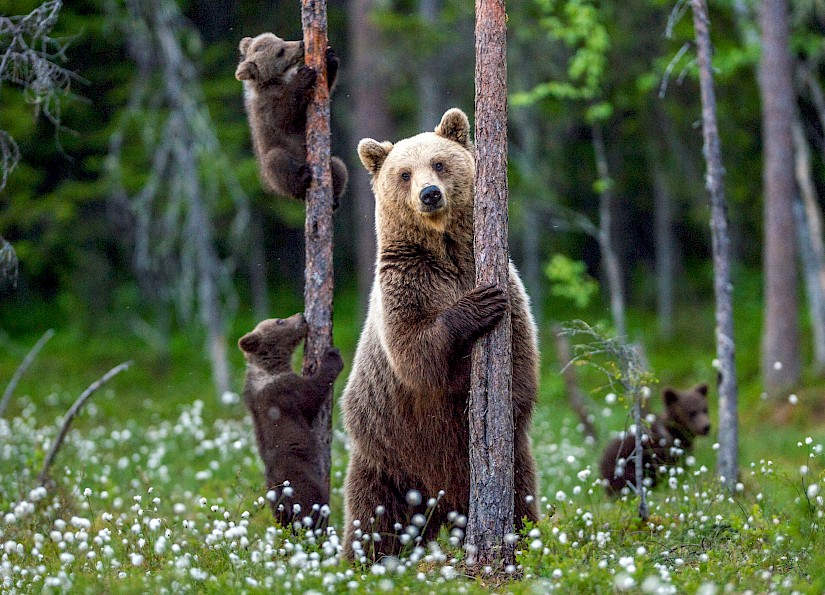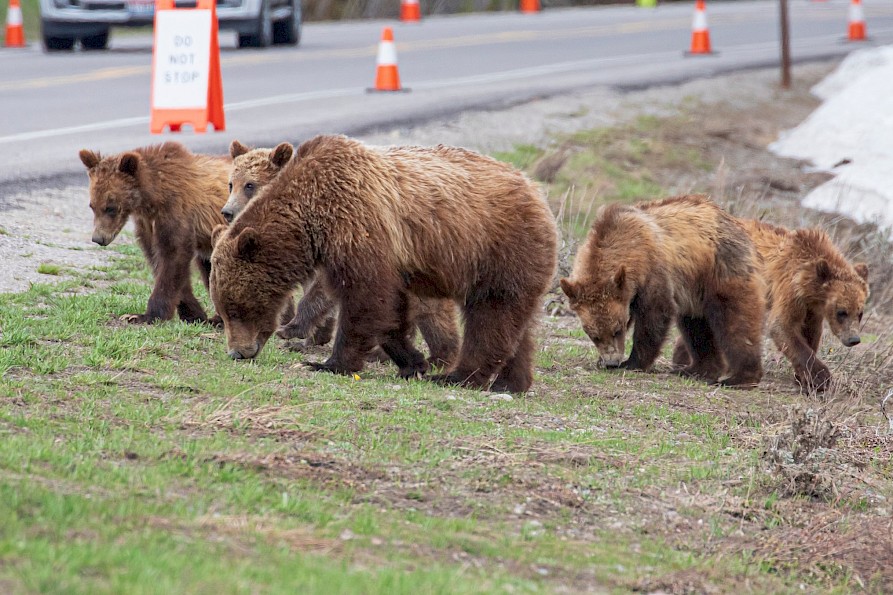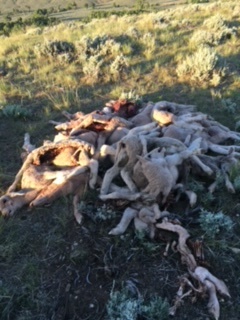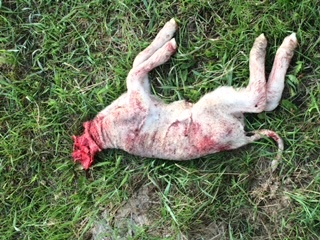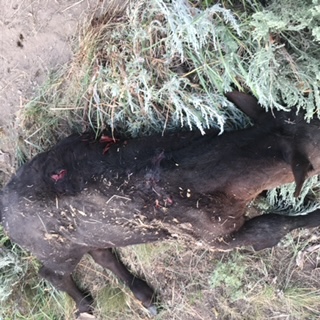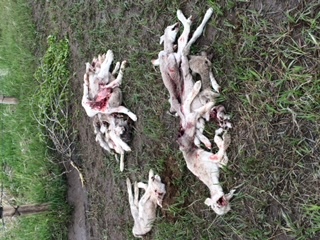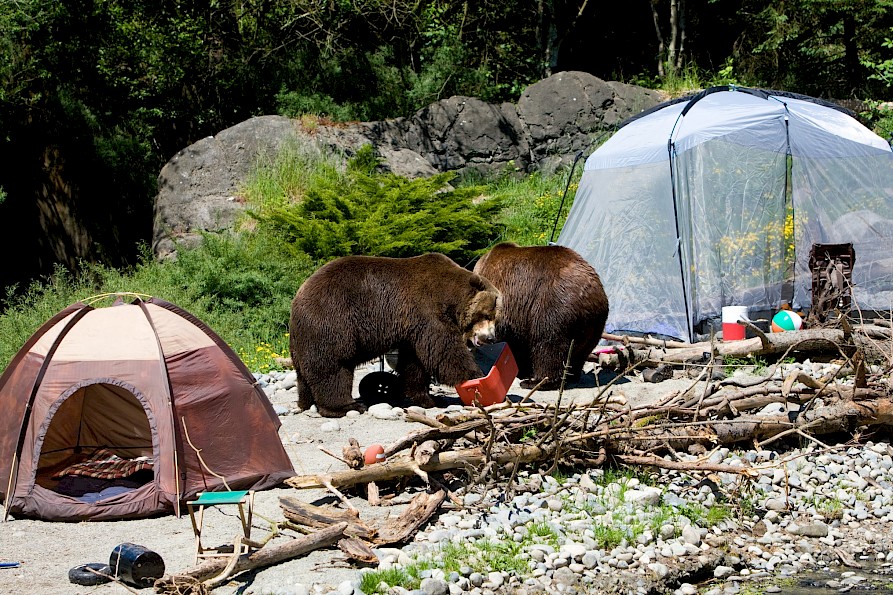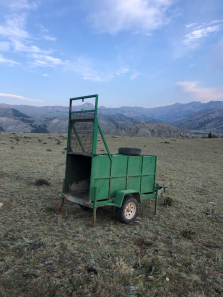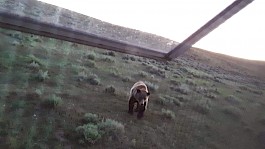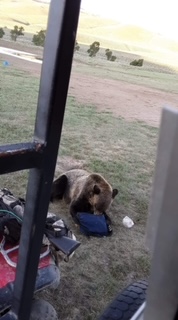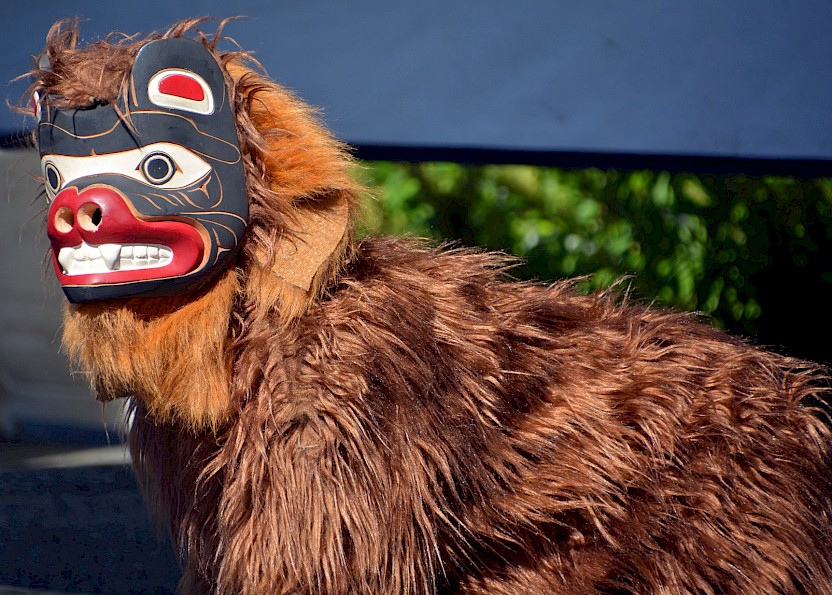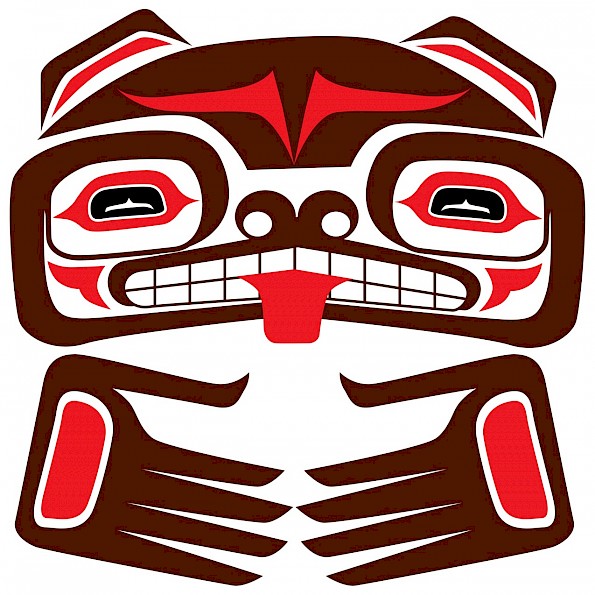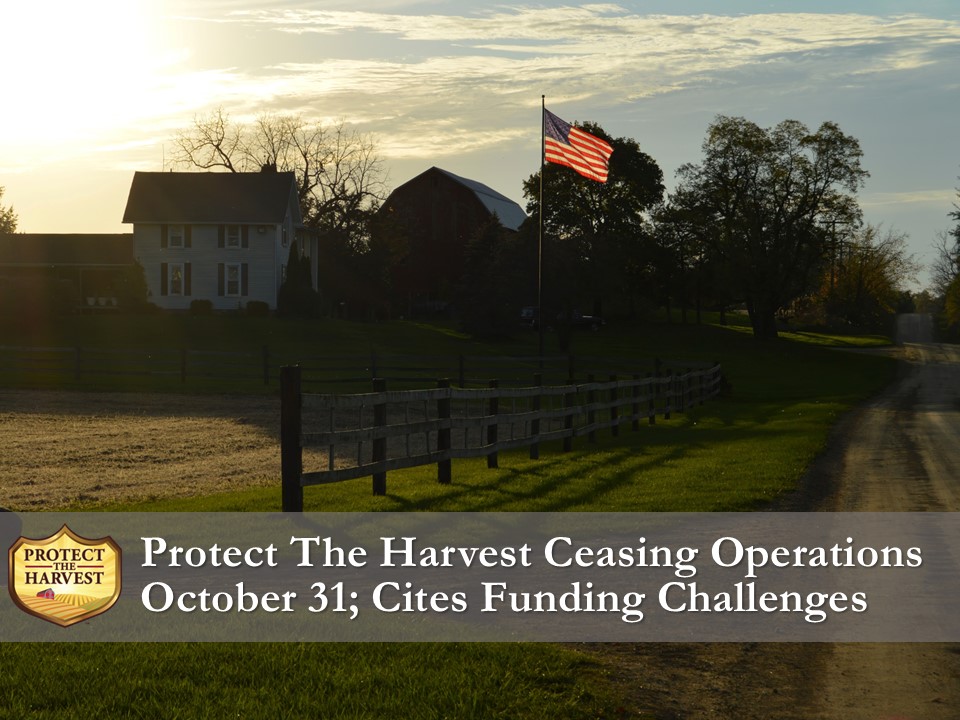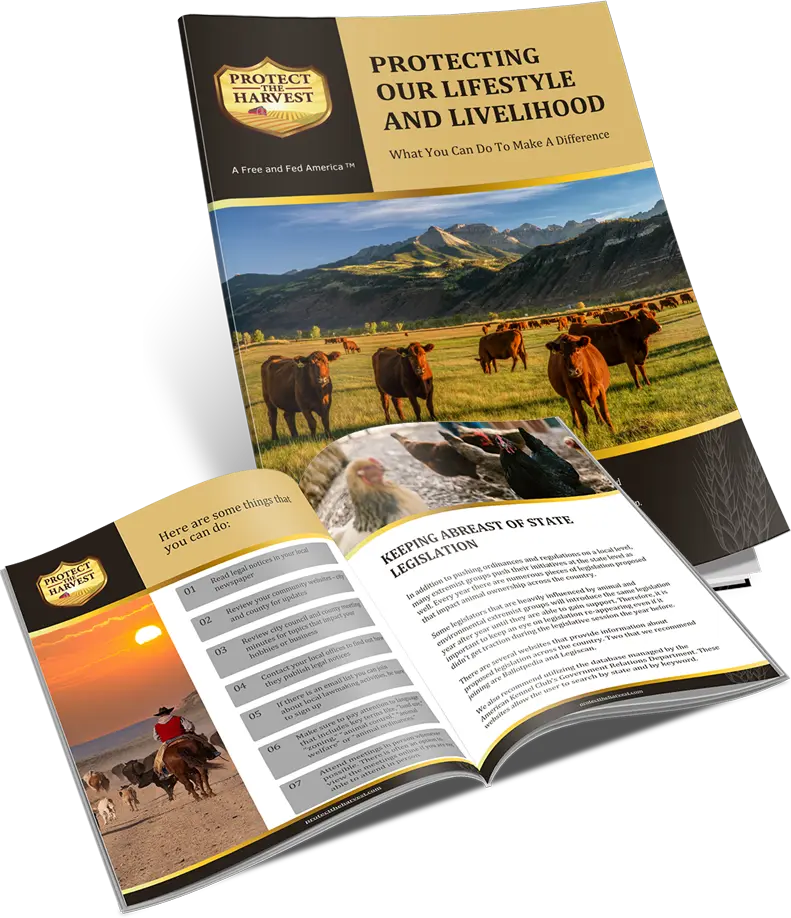MAN, YOU HAVE A PROBLEM – GRIZZLY BEAR BEHAVIOR IN WYOMING IS A REFLECTION
Are You Afraid to Let Your Children Play Outside?
- Imagine being afraid to let your children play outside in your backyard.
- Imagine being concerned about walking to your garage.
- Imagine not being able to protect your animals.
- Imagine finding your animals strewn all over your property dead and with horrific wounds.
- Imagine being promised reimbursement for hundreds of thousands of dollars in business losses caused by government policy and having to fight for years to receive a small portion.
This is what life is like for ranchers in Wyoming who have been subjected to ineffective Federal Grizzly Bear policies.
The Definition of Insanity is Doing the Same Thing Over and Over Again and Expecting Different Results
It is clear that the federal government, as well as environmentalist groups that influence policy, have not learned from past mistakes. The Grizzly bear issue in Wyoming is simply a mirror of a larger problem. The actions of man have upset environmental balance, not just in Wyoming but in other areas of the country. Over the last number of years, there have been many issues where the over protection of one species has unbalanced the ecosystem, leading to the devastation of other species and the development of unnatural behaviors. These unnatural behaviors of grizzly bears and wolves are being witnessed by ranchers due to the killing and maiming livestock for sport instead of for food.
These “protections” are put into place without the consideration of proper balance. In the name of conservation humans have stepped into the equation without considering their own part in the ecosystem. Man has always been a part of the natural ecosystem by controlling apex predators and providing balance. History has clearly shown this and the proof is the stewardship and balance of man in nature with the native peoples that inhabited North America before the arrival of Europeans.
Sealions, Sea Otters, Wolves, Rangeland Horses and More
The sealion issue on the west coast is just one example of how “protection” goes too far and creates further imbalance and unnatural behaviors. Soon after the California sea lion became protected, their numbers skyrocketed. This decimated the salmon population impacting other endangered species that relied on them, including the orca. The exploding sea lion population discovered fish ladders on the Columbia River and its tributaries. The sealions that discovered the easy meal then taught others. They also started engaging in unnatural behaviors of spree killing at the fish ladders. All this has added up to sealions migrating and remaining in fresh-water areas where they do not belong, further wiping out salmon runs.
Sea otters provide another example. Since being added to the endangered species list, and also with intervention, the population of sea otters has exploded. They are voracious eaters, and their population has now had devastating impact on shellfish, Dungeness crab, and sea urchins.
The reintroduction of wolves has become a big problem in Oregon, Idaho, Montana, Washington, California, Minnesota, and Wyoming. The Elk population in Yellowstone has decreased significantly since wolves were introduced.
In 1971, Congress passed the Wild Horse and Burro Act. The intent was to save an American icon: rangeland horses. For over two hundred years, those horses were managed by both native peoples and European settlers. The horses were used for transportation, military, Army Cavalry mounts, farming, hunting, livestock management, and as a food source. However, with interference of radical animal and environmental extremist groups, the federal government has been blocked from properly managing the horse populations at every turn. These “wild horse advocate” groups are continually striving to take human intervention out of the equation. Humans have always been part of the equation when it comes to horses on American rangelands. The result is a devastated ecosystem which is harming native wildlife and the horses themselves. Due to lack of feed and water resources horses on our American rangelands are dying from starvation and dehydration along with other native wildlife. The population of those horses is more than four times the number biologists and scientists recommend for a healthy, balanced and thriving ecosystem. American taxpayers are paying over $50,000,000 per year to board and feed over 50,000 rangeland horses which have been removed from the rangelands to protect their welfare. There is no end in sight with thousands more born every year.
Man, You Have a Problem
There are more species that can be listed as examples where intervention has caused harm, especially intervention where the commonsense approach of leaving humans in the picture is absent.
An article that clearly outlines the problems that arise was published in Scientific American and titled, “When One Protected Species Kills Another, What Are Conservationists to Do?”
“In a world where wildlife is threatened like never before in human history, the conservationist’s mission seems clear: work to stop wildlife from going extinct, and to recover populations that have declined to the brink of extinction. In general, protecting wildlife means reducing a species’ mortality by mitigating or eliminating threats. This has often been as simple as shielding or restoring a key habitat or removing a non-native species that competes for resources.
But in today’s increasingly disrupted natural environment, sometimes the biggest threat facing a species that conservationists are trying to protect and recover is … another species that conservationists are trying to protect and recover. When that happens, the solutions available to environmentalists and wildlife managers get complicated and messy very quickly. ‘One of the challenges that we face today in marine conservation is how to manage through success,’ says marine biologist Christopher Lowe, director of the Shark Lab at California State University Long Beach. ‘As populations recover they create new, unforeseen interactions that can often pit protected species against each other—even though many have historically interacted ecologically.’”
Grizzly Bears in Wyoming
In 1975, the grizzly bear was listed as a threatened species. A recovery plan was developed in 1982, and revised in 1993. Since then the grizzly bear population has recovered and has outgrown the ecosystem in Yellowstone and other designated management areas. The ecosystem in Yellowstone simply cannot handle the bear population and so they are migrating to other areas and will continue to do so as pressure increases.
In 2014, regulations were changed allowing for the management of conflict bears. This regulation outlined by the US Fish and Wildlife Service allowed for taking of grizzly bears in self-defense or the defense of others. It also provided rules for dealing with nuisance bears. According to the regulation, “A grizzly bear constituting a demonstrable but non immediate threat to human safety or committing significant depredations to lawfully present livestock, crops, or beehives may be taken, but only if: (1) It has not been reasonably possible to eliminate such threat or depredation by live-capturing and releasing unharmed in a remote area the grizzly bear involved; and (2) The taking is done in a humane manner by authorized Federal, State, or Tribal authorities, and in accordance with current interagency guidelines covering the taking of such nuisance bears;.”
How Ranchers and Campers Have Been Impacted by Grizzly Bear Overpopulation of Their Ecosystem
We spoke with some Wyoming ranchers to learn more about what is happening. The Grizzly bear population in the areas surrounding Yellowstone have exploded. They have more than reached their ideal population number and are expanding their range from the Yellowstone area to private property. These Wyoming ranchers reported dealing with more than simply having to co-exist with an apex predator.
What they relayed to us is chilling both from the perspective of private property ownership and animal welfare considering that grizzly bears in the area are acting in unnatural ways. To make matters worse, younger bears are learning the same behaviors. The bottom line is that grizzly bears are being protected over human and private property rights.
In addition to preying on livestock, grizzly bears have developed unnatural behaviors and are going on killing sprees. They are roaming onto ranches killing large numbers of livestock for food and for sport. They are roaming onto ranch homesteads scavenging in garages and barns and coming within near feet of houses. They are also roaming into campgrounds and small communities. In addition to their devastating impact on livestock, grizzlies have been killing hikers and tourists. Recently a woman on a cross country bike trip was pulled out of her tent and killed.
An article in the Powell Tribune reported:
“By July 1, seven people were attacked and injured by grizzly bears in the Greater Yellowstone Ecosystem —more than the first six months of any other year since data began being collected in 1992,”
“This is a higher total than six of the previous 10 years and [an] unsettling trend since over 80% of the conflicts generally occur in the second half of the year.”
The grizzlies are doing more damage to livestock in addition to killing for food and killing large numbers of calves and lambs for sport. The ranchers described scenes of cows running full speed for miles to get away from the predators. The free-for all killing and roaming onto private land by the bears is causing livestock great stress, driving them miles away from grazing areas on private land. Ranchers are not only experiencing losses from the death of their livestock but others as well. Stress to the cattle is causing weight loss, aborted calves, and is impacting fertility and conception rates.
Nuisance Bears Won’t Take No for An Answer
The numbers of nuisance bears on private land is continuing to grow. The ranchers we spoke with reported that they had four bears removed from their private property this summer alone, which is located more than forty miles from Yellowstone. So far, relocation which is the solution for nuisance bears, is not satisfactory because they quickly make their way back to where there is easy food. This is a phenomenon seen in sealion populations as well. Sealions have been removed and dropped off hundreds and hundreds of miles away, only to have them return within a week or two. Removal and relocation only trains the bears. Now the bear is smarter and harder to catch the next time around and they steer clear of the culvert traps set by the U.S. Department of Fish and Game.
The Ranchers Only Want to Protect Their Property and to Be Properly Reimbursed for Losses
Please do not mistake the intentions of ranchers in the area. They do not want to see the bears irradicated. However, they do want to be able to protect their livestock, their property, their families, and employees from the dangers the bears present. They want to be able to coexist with bears and not at their unnatural numbers. Currently, bears may not be culled even in the act of protecting livestock, and only if the bear has directly charged or made physical contact with a human.
Have you ever been face to face with a grizzly bear? Do you have any idea how fast they move? The chance to survive is limited let alone eliminating the threat the bear poses.
The penalty for killing a bear is ten years in prison and a $25,000 fine.
Proponents of current bear management strategies make claims that ranchers are reimbursed for losses. They make the same claims regarding the reintroduction of wolves as well. This is far from the case. The process is complicated and not straight forward. Often, when the grizzlies go on a killing spree, they leave carcasses spread out for miles requiring hours of travel to find the total of the number killed.
The losses are not properly calculated when looking at the big picture of deaths, weight loss, scattered livestock, abortions, and low conception rates. Ranchers from the HD Ranch in Thermopolis, Wyoming have not been paid for grizzly damage since 2017. Their damage claims are climbing along with the grizzly population. In 2012, their first damage claim was $6,000 and in 2017, it has grown to $500,000. Founded in the 1800’s, the HD Ranch comprises of over 85,000 deeded acres and holds grazing permits on over 50,000 acres with the State of Wyoming and the Bureau of Land Management.
According to the ranchers, over the years the State of Wyoming has spent $90,000,000 on the grizzly bear issue and has yet to achieve proper management. This is why Wyoming Governor Gordon has announced they are petitioning the US Fish and Wildlife Service to delist the grizzly bear population and is requesting state management of the grizzly bears in the Greater Yellowstone Ecosystem.
A September 2021 article in Rocket Miner states:
“The State is petitioning the U.S. Fish and Wildlife Service to delist the GYE grizzly bear population, following 46 years and more than $52 million in investment from Wyoming. Grizzly bears, by all measures, have been fully-recovered since 2003.”
“This is a notable day of celebration not only for the grizzly bear, but for Wyoming. The Greater Yellowstone Ecosystem grizzly bear has met and exceeded all scientific benchmarks for recovery,” Governor Gordon said in a press conference. “We have proved time and time again that we are experts in wildlife conservation for our state’s valued and iconic species. It’s time for grizzly bears to be returned fully to the states for management, as our citizens have supported recovery efforts and seen monumental success.”
Interference of Animal and Environmental Extremist Groups
Of course, the usual environmental extremist suspects are involved in this mess. Groups such as Defenders of Wildlife, WildEarth Guardians, Center for Biological Diversity and Sierra Club and others never miss a chance to file lawsuits and reap the financial benefits of the Equal Access to Justice Act.
An article by the Powell Tribune outlines their tactics:
“A coalition of environmental groups — who persuaded courts to reinstate endangered species protections for the greater Yellowstone area’s grizzly bears — say the federal government should be ordered to pay $1.4 million to cover their attorneys’ fees and costs.”
“Both the Equal Access Justice Act and the Endangered Species Act include provisions that allow prevailing parties to recoup their costs, with the thought that they’re doing a public service by holding government accountable to the law.”
“However, the vice president of the Wyoming Game and Fish Commission testified in a U.S. Senate committee hearing Wednesday that the ‘vast amounts’ of money pulled in by environmental organizations for opposing the removal of species from protection under the Endangered Species Act is one of the reasons only 2% of species listed has been removed from the list.”
“Pat Crank, an attorney from Cheyenne, said environmental groups can generate “incredible” revenue by challenging any delisting, ‘no matter what the facts are.’”
“Not only is litigation popular with donors, Crank said during a Senate Committee on Environment and Public Works hearing, but lawyers are seeking increasingly high reimbursement for their fees.”
“‘If they’re successful in Endangered Species Act litigation, all their attorney fees get paid,’” he said, specifically mentioning the $1.4 million being sought in the grizzly delisting case.”
The Sacred Bear and The Bigger Picture
Native American tribes consider the grizzly a sacred animal. Killing bears for the sake of culling and managing a man-made problem is a direct affront and insult to their culture and customs. When researching this article we knew it was critical to consult those who were the first stewards of the land in the Americas. We spoke with Chief of the North Cheyenne, Phillip Whiteman about the issue. His words helped frame this article and bring forth titles to topics.
The grizzly bear is a teller of tales. Chief Whiteman expressed that the grizzly bear itself is not the problem. It is man’s interference with the balance of nature and adherence to hard and fast regulations which is driving the grizzly to behave in unnatural ways, threatening lives and the ecosystem balance. Chief Whiteman talked about how the grizzly is allowing man to recognize that we are in a unique situation to bring expanded awareness that we are connected to the earth and each other. He believes that we are at a pivot point. He asks all of us to consider that the earth is not ours and it belongs to our grandchildren and their grandchildren. He believes we need to look at this issue from a different perspective and that we cannot solve a problem with the same mindset that created it. We are stewards and are not doing a good job. The grizzly is a vehicle to get the truth out. Therefore, a different alternative is needed.
Going Forward
There is no doubt that viable solutions and balance must be achieved.
When environmental extremist groups get involved, the only ones who benefit are those same groups. They benefit personally from gathering donations off the grizzly bear and from the legal fees they collect from their lawsuits which block commonsense management efforts. It is important to note they collect large sums paid by US taxpayers under the Equal Access to Justice Act via their lawsuits. The end result is they collect huge fees, pay themselves comfortable salaries and the bears and those impacted by them do not benefit from their actions.
When the federal government gets involved, the wheel is recreated. Red tape and stringent regulations get in the way of commonsense approaches. States also have the same issues with red tape and regulations as well as bearing the burden of the expense of management .
For everyone’s sake, the grizzlies, livestock, ranchers, tourists, enthusiasts, native wildlife, native cultures, future generations, and the ecosystem we must stop doing the same thing over and over again. This leads to an obvious question. If the native tribes were stewards of the land and managed the ecosystem as a part of it, and if the grizzly bear holds a sacred place, who is best to solve our problems of an unbalanced ecosystem?
Links to Resources
Understand the Cultural Meaning Behind the Grizzly Bear as Seen by Native Americans HERE
Ranching in the West – Setting the Record Straight HERE
Articles about Grizzlies in Wyoming
Wyoming Governor Asks for Delisting and to Take Over Management of Grizzly Population HERE
Wyoming Ranchers and Farmers Now Endangerd Not Grizzlies HERE
Ranchers Request Rejected by Fish and Game HERE
Grizzly Bear Removed from North Fork Guest Ranch HERE
Wyoming Grizzly Bear Update HERE
Ranching Families Advance Effort to Appeal Grizzly Ruling HERE
Bear Lawsuit Brings Big Tab HERE
Center for Biological Diversity Lawsuit – Claims Grazing Impacts Grizzly Bear Population – USFWS Says Not the Case HERE
Grizzly Bear Numbers
Wyoming Fish and Game On Grizzly Bear StatusHERE
Judges Question Wyomings Case on Grizzly Numbers HERE
Grizzly Presence Confirmed in Southern Wyoming – Furthest South Since Well Before 1970’s HERE
Sighting in Kemmerer Sign of Recovered Bear Populations HERE
US Fish and Wildlife – Grizzly Bear Five Year Status Review HERE
US Fish and Wildlife – 2020 Grizzly Bear Recovery Report HERE
Wyoming Fish and Game – Grizzly Bear Delisting HERE
US Fish and Wildlife – Species Status Assessment HERE
CBS News – 60 Minutes – Montana Grizzly Bears Population Returning HERE
Issues with Other Species
Wolves – Wolf Reintroduction a Mistake Says Former State Wildlife Commissioner HERE
Wolves – Yellowstone Park – Gray Wolves Impact Elk HERE
Scientific American – When One Protected Species Kills Another What are Conservationists to Do HERE
Salmon, Sturegon and Orcas Need Protection from HSUS HERE
Sealions – Important Bill Passes Sentate HERE
Sealions – Endangered Salmon Predation Act Passes with Bipartisan Support HERE
Rangeland Horses – Animal Rights Extremist Groups Fighting Against Each Other HERE
Rangeland Horses – Western Horseman – Mustangs in Crisis HERE
Rangeland Horses – Animal Welfare Crisis on American Rangelands HERE
How NGOs Are Impacting Our American Rangelands HERE
Overview of Environmental Extremist Groups – Landing Page to Separate Articles HERE
Overview of Animal Extremist Groups – Landing Page to Separate Articles HERE

